GHRH
-
Official Full Name
Ghrh growth hormone releasing hormone -
Overview
The protein encoded by this gene belongs to the glucagon family and is a preproprotein that is produced in the;hypothalamus. The preproprotein is cleaved to form a 44 aa factor, also called somatocrinin, that acts to stimulate;growth hormone release from the pituitary. Variant receptors for somatocrinin have been found in several types of;tumors, and antagonists of these receptors can inhibit the growth of the tumors. Defects in this gene are a cause of;dwarfism, while hypersecretion of the encoded protein is a cause of gigantism. -
Synonyms
GHRH;growth hormone releasing hormone;somatoliberin;GRF;growth hormone-releasing factor;growth hormone-releasing hormone;GHRF
Recombinant Proteins
- Human
- Rat
- Chicken
- Zebrafish
- Mouse
- Sheep
- E.coli
- Human
- HEK293
- Mammalian Cells
- Wheat Germ
- In Vitro Cell Free System
- His
- Non
- Fc
- GST
- Avi
Background
What is GHRH protein?
GHRH (growth hormone releasing hormone) gene is a protein coding gene which situated on the long arm of chromosome 20 at locus 20q11. This gene encodes a member of the glucagon family of proteins. The encoded preproprotein is produced in the hypothalamus and cleaved to generate the mature factor, known as somatoliberin, which acts to stimulate growth hormone release from the pituitary gland. Variant receptors for somatoliberin have been found in several types of tumors, and antagonists of these receptors can inhibit the growth of the tumors. Defects in this gene are a cause of dwarfism, while hypersecretion of the encoded protein is a cause of gigantism. The GHRH protein is consisted of 108 amino acids and its molecular mass is approximately 12.4 kDa.
What is the function of GHRH protein?
GHRH is the primary neuroendocrine regulator of GH secretion. It stimulates the pituitary gland to release GH, which controls the metabolism and growth of every tissue in the body. Through its stimulation of GH release, GHRH indirectly affects various metabolic processes, including protein synthesis, fat breakdown, and glucose homeostasis. GHRH has also been linked to cognitive function and the central nervous system. It is thought to have neuroprotective effects and may be involved in learning and memory processes. Research has explored the relationship between GHRH, GH, and the aging process. There is interest in understanding whether GHRH can influence lifespan or age-related changes, although more research is needed in this area. GHRH is sometimes used illicitly in sports to try to enhance athletic performance due to its effects on muscle growth and body composition. However, this use is controversial and can have serious health risks.
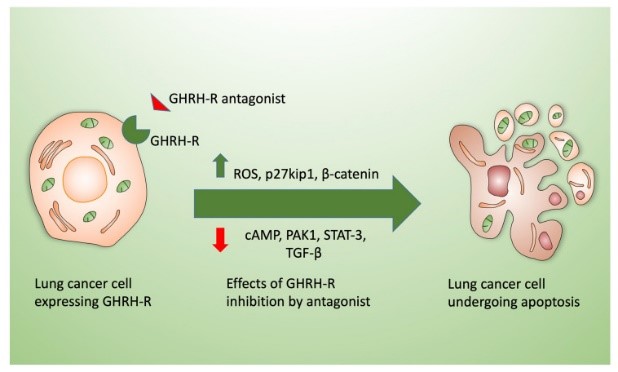
Fig1. Effects of GHRH-R antagonists on lung cancer cells. (Chongxu Zhang, 2020)
GHRH Related Signaling Pathway
GHRH binds to its receptor, the GHRH receptor (GHRHR), which is a member of the B class of G protein-coupled receptors (GPCRs). This interaction primarily activates the adenylate cyclase pathway, leading to an increase in cyclic AMP (cAMP) levels. The rise in cAMP then stimulates protein kinase A (PKA), which in turn promotes the secretion of growth hormone from the anterior pituitary gland. The secretion of GH is also linked to the activation of the Janus kinase (JAK) and Signal Transducers and Activators of Transcription (STAT) pathways. Specifically, JAK2 is activated, leading to the phosphorylation and activation of STAT proteins, which then regulate the expression of target genes. The GHRH-GHRHR interaction can also activate the mitogen-activated protein kinase (MAPK) or extracellular signal-regulated kinase (ERK) pathway, which is involved in cell proliferation and differentiation. In addition to the cAMP pathway, GHRH can also activate phospholipase C (PLC), leading to an increase in intracellular calcium levels (Ca2+).
GHRH Related Diseases
GHRH is associated with several diseases and conditions, primarily due to its role in regulating the secretion of growth hormone (GH) from the pituitary gland. A deficiency in GHRH can lead to reduced levels of growth hormone, causing growth failure, short stature, and delayed growth in children. In adults, it can lead to body composition changes, decreased exercise capacity, and adverse metabolic and cardiovascular changes. Abnormal expression of GHRH and its receptor has been observed in various types of cancer. For instance, GHRH and its receptor are being studied for their potential roles in the progression of gastric and esophageal cancers. GHRH has been misused in sports to try to enhance performance due to its effects on muscle growth and body composition. However, this is prohibited and can have serious health consequences. Excessive secretion of GHRH can lead to an overproduction of growth hormone, resulting in acromegaly, a condition characterized by abnormal growth of the hands, feet, and facial features.
Bioapplications of GHRH
GHRH or its analogs can be used to treat conditions where there is a deficiency in growth hormone, such as in children with short stature or adults with AGHD. By stimulating the pituitary to produce more GH, it can help to normalize growth patterns and improve body composition. The study of GHRH and its receptor provides opportunities for the development of new drugs that can target the GHRH pathway for various therapeutic applications, including the treatment of metabolic disorders and possibly other conditions related to GH dysregulation.
Case Study
Case Study 1: David Garcia-Galiano, 2020
Gonadal steroids modulate growth hormone (GH) secretion and the pubertal growth spurt via undefined central pathways. GH-releasing hormone (GHRH) neurons express estrogen receptor α (ERα) and androgen receptor (AR), suggesting changing levels of gonadal steroids during puberty directly modulate the somatotropic axis. The researchers generated mice with deletion of ERα in GHRH cells (GHRHΔERα), which displayed reduced body length in both sexes. Timing of puberty onset was similar in both groups, but puberty completion was delayed in GHRHΔERα females. Lack of AR in GHRH cells (GHRHΔAR mice) induced no changes in body length, but puberty completion was also delayed in females. Using a mouse model with two reporter genes, they observed that, while GHRHtdTom neurons minimally colocalize with Kiss1hrGFP in prepubertal mice, ∼30% of GHRH neurons coexpressed both reporter genes in adult females, but not in males. Developmental analysis of Ghrh and Kiss1 expression suggested that a subpopulation of ERα neurons in the arcuate nucleus of female mice undergoes a shift in phenotype, from GHRH to Kiss1, during pubertal transition.
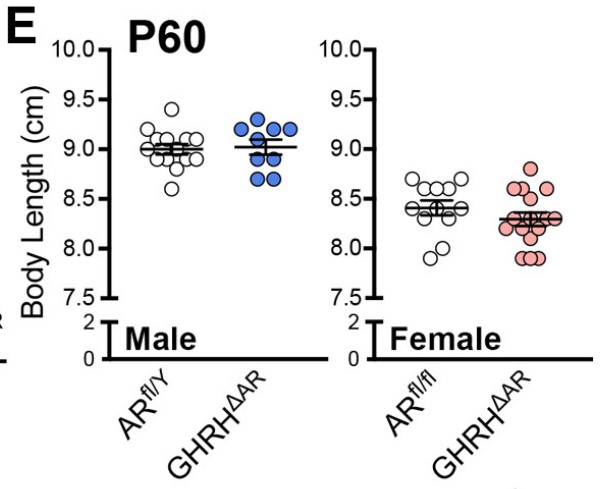
Fig1. Body length at P60 in GHRHΔAR versus ARfl/Y males and GHRHΔAR versus ARfl/fl females.
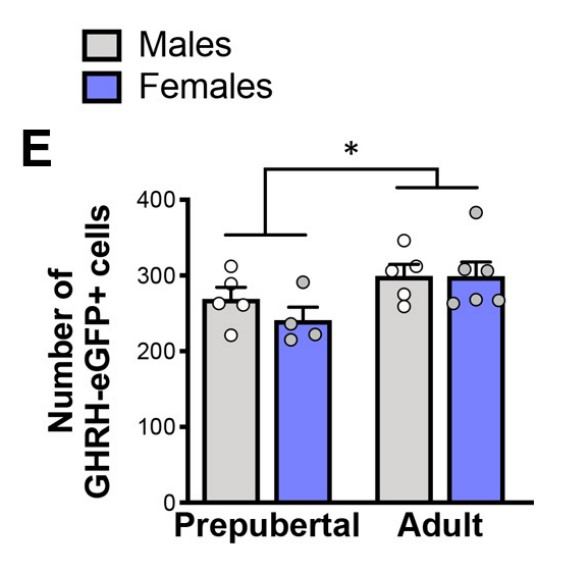
Fig2. Quantification of number of ARH GHRH-eGFP+ neurons during pubertal transition in males and females.
Case Study 2: Arokia Priyanka Vaz, 2016
Nutrition during the early postnatal period can program the growth trajectory and adult size. Nutritionally regulated hormones are strongly suspected to be involved in this physiological regulation. Linear growth during the postnatal period is regulated by the neuroendocrine somatotropic axis, whose development is first controlled by GHRH neurons of the hypothalamus. Leptin that is secreted by adipocytes in proportion to fat mass is one of the most widely studied nutritional factors, with a programming effect in the hypothalamus. However, it remains unclear whether leptin stimulates the development of GHRH neurons directly. Using a Ghrh-eGFP mouse model, the researchers show here that leptin can directly stimulate the axonal growth of GHRH neurons in vitro in arcuate explant cultures. Moreover, GHRH neurons in arcuate explants harvested from underfed pups were insensitive to the induction of axonal growth by leptin, whereas AgRP neurons in these explants were responsive to leptin treatment. This insensitivity was associated with altered activating capacities of the three JAK2, AKT and ERK signaling pathways.
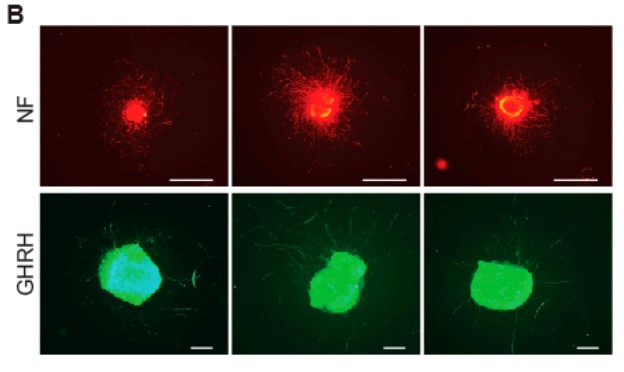
Fig3. Illustrative images of dual IHC for the axons of total arcuate nucleus neurons labeled with NF and GHRH neurons labeled with eGFP.
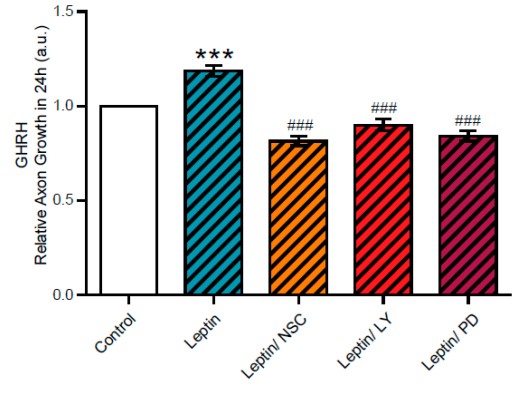
Fig4. Signaling pathways involved in the axon growth of arcuate neurons in explants from normally fed pups.
Quality Guarantee
High Purity
.jpg)
Fig1. SDS-PAGE (GHRH-661H)
.
.jpg)
Fig2. SDS-PAGE (GHRH-4888H)
Involved Pathway
GHRH involved in several pathways and played different roles in them. We selected most pathways GHRH participated on our site, such as Class B/2 (Secretin family receptors),G alpha (s) signalling events,GPCR downstream signaling, which may be useful for your reference. Also, other proteins which involved in the same pathway with GHRH were listed below. Creative BioMart supplied nearly all the proteins listed, you can search them on our site.
| Pathway Name | Pathway Related Protein |
|---|---|
| Signaling by GPCR | ARHGEF17,PROK1,NET1,TAC3,TAS2R3,S1PR5B,OR52J3,RGS6,RGS20,GNA13B |
| G alpha (s) signalling events | RAMP2,CALCB,RLN3,GCGA,ADM2,CALCA,NPSR1,POMCB,VIP,ADORA2B |
| Class B/2 (Secretin family receptors) | CD97,ADCYAP1R1,RAMP2,EMR1,FZD10,GCGA,CRHB,GNB3A,EMR4,ADM2A |
| GPCR ligand binding | PROKR1A,GNB5A,GPR17,CCL19A.2,OXTRL,KEL,GPR65,GPR55,ADCYAP1R1,PMCH |
| Signal Transduction | S1PR3,SPOP,BCL9L,HEYL,CHRDL1,ARHGAP4,ARHGEF1A,RBP1,ARHGEF18A,CXCL11.8 |
| GPCR downstream signaling | RXFP2B,OPN4B,RHOC,UTS2D,RGS12,QRFP,ADORA1,ARHGEF18A,NMBA,APPB |
Protein Function
GHRH has several biochemical functions, for example, growth hormone-releasing hormone activity,growth hormone-releasing hormone receptor binding. Some of the functions are cooperated with other proteins, some of the functions could acted by GHRH itself. We selected most functions GHRH had, and list some proteins which have the same functions with GHRH. You can find most of the proteins on our site.
| Function | Related Protein |
|---|---|
| growth hormone-releasing hormone activity | GHRL |
Interacting Protein
GHRH has direct interactions with proteins and molecules. Those interactions were detected by several methods such as yeast two hybrid, co-IP, pull-down and so on. We selected proteins and molecules interacted with GHRH here. Most of them are supplied by our site. Hope this information will be useful for your research of GHRH.
DPP4;FAP
Resources
Related Services
Related Products
References
- Stanley, TL; Grinspoon, SK; et al. Effects of growth hormone-releasing hormone on visceral fat, metabolic, and cardiovascular indices in human studies. GROWTH HORMONE & IGF RESEARCH 25:59-65(2015).
- Qi, QE; Xi, QY; et al. Alteration of the miRNA expression profile in male porcine anterior pituitary cells in response to GHRH and CST and analysis of the potential roles for miRNAs in regulating GH. GROWTH HORMONE & IGF RESEARCH 25:66-74(2015).



